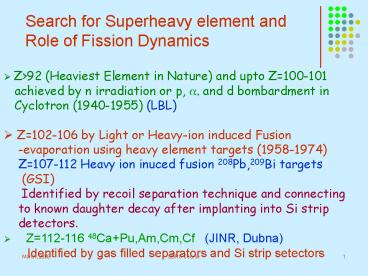Z92 Heaviest Element in Nature and upto Z100101 - PowerPoint PPT Presentation
1 / 47
Title:
Z92 Heaviest Element in Nature and upto Z100101
Description:
Z=102-106 by Light or Heavy-ion induced Fusion -evaporation using heavy element targets (1958-1974) ... Effective fissility : weighted mean of mono-nuclear and binary ... – PowerPoint PPT presentation
Number of Views:54
Avg rating:3.0/5.0
Title: Z92 Heaviest Element in Nature and upto Z100101
1
Search for Superheavy element and Role of
Fission Dynamics
- Zgt92 (Heaviest Element in Nature) and upto
Z100-101 - achieved by n irradiation or p, a, and d
bombardment in - Cyclotron (1940-1955) (LBL)
- Z102-106 by Light or Heavy-ion induced Fusion
- -evaporation using heavy element targets
(1958-1974) - Z107-112 Heavy ion inuced fusion 208Pb,209Bi
targets - (GSI)
- Identified by recoil separation technique
and connecting - to known daughter decay after implanting into
Si strip - detectors.
- Z112-116 48CaPu,Am,Cm,Cf (JINR, Dubna)
- Identified by gas filled separators and Si
strip setectors
2
(No Transcript)
3
(No Transcript)
4
(No Transcript)
5
(No Transcript)
6
Cross-section data and extrapolated values for
cold-fusion Reactions (1n -evaporation channel)
Cross-section increases with increasing isospin
7
(No Transcript)
8
E33 MeV
E34-38 MeV
48Ca244Pu-gt2891143n
48Ca244Pu-gt2881144n
48Ca242Pu-gt2871143n
9
Yury Ts. OganessianPure Appl. Chem., Vol. 76, No.
9, pp. 17151734, 2004.
10
(No Transcript)
11
48Ca244Pu
12
(No Transcript)
13
The flight time of the reaction products through
SHIP is 2 ms.
14
(No Transcript)
15
(No Transcript)
16
Cold Fusion 208Pb and 209Bi targets
bombarded by the following projectiles 48Ca,
50Ti, 54Cr,58Fe, 62Ni, 64Ni, 70Zn, 76Ge, 82Se,
and 86Kr. ? Hot Fusion 48Ca projectiles
bombarded targets of 238U, 244Pu, 243Am, 245Cm,
248Cm, and 249Cf,
17
BLDf gradually disappears
Spherical
Deformed
18
Fission barrier calculations of Smolanzuk et al.
106Sg has highest barrier with half life of 3 hrs
19
(No Transcript)
20
For Z1Z2gt1000 to 1650 depending on the value of
the charge asymmetry, Zp/ZT.
Extra push energies
Swiatecki
21
No hindrance
Onset of fusion limitation Due to Extra push
energies
Effective fissility weighted mean of
mono-nuclear and binary With weight for binary
taken as 1/3
22
(No Transcript)
23
Injection direction
Difference in energy Between touching Point and
saddle point Small due to shell structure Of Ca
and Pb
Fusion area inside Saddle point
All trajectories reaches fusion
24
Quasi-fission is dominant
Extra pocket in mass Symmetric region
Deep Quasi- fission
25
Evgeni A. Cherepanov Brazilian Journal of
Physics, vol. 34, no. 3A, September, 2004
The curve V (Z,L 0) (for the value of R
corresponding to the pocket) has a few local
minima, which reflect the shell structure in the
interacting nuclei.
26
Mass asymm fluctuates around 0.5 and then
relaxes quickly and Trajectory move to main
48Ca208Pb EX50 MeV
Aritomo and Ohta Pre-print
Nuclear Physics A 744 (2004) 314
27
Critical stage
For FF mass Asymmetries large
Turning stage
For QF neck develops and speeds up
fission keeping mass asymm.
For deep QF mass asymm Relaxed in sub-pocket At TS
48Ca244Pu Ex50 MeV
28
(No Transcript)
29
The smaller formation probability due to
inhibition of fusion by competing
mechanismDIC,QF,FF,PEF Asymmetric channels
higher E
and unfavourable for survival
30
Transition from FF to QF
Mass distribution for FF is asymmetric in
shape With peak around 132
QF
31
Measurements at LNL,Legnaro (Italy)
470-630 MeV 80Se 208Pb 372 MeV
56Fe232Th
288116
80Se 232Th
312124
470-630 MeV
Measurement of fragment mass and kinetic energy
and neutron correlations
32
Schematics of the setup for SePb,Th experiment
33
80Se232Th
470 MeV
80Se208Pb
470 MeV
DIC dominates but significant events around
symmetry
34
SePb more asymmetric compared to SeTh
QF is expected to be more for SeTh
80Se232Th
470 MeV
80Se208Pb
470 MeV
35
higher extra-push energy in the case of
80Se232Th
36
80Se208Pb
288116
80Se232Th
312124
? sf tot 102 for SePb 121
for FeTh 172 for SeTh
37
on average of about 0.6 neutron per unit Z
38
an increase of about 0.54 neutron per unit Z
excitation energy gained by the system in its
transition from the saddle to the scission point
(the term ?Ex by Hilscher) that is known to show
a strong mass and Z dependence.
39
JINR,Dubna
40
41 detectors of DEMON at Dubna T. Materna et al.
Nuclear Physics A734 (2004) 184-l 87
20820
QF
FF
A/230
The pre-scission neutron multiplicity
distribution simulated using backtracing
procedure show two components for CaPu Whereas
for CaPb only one component is seen
41
??
Self-consistent
Connectecd with known species
42
Change from Hot fusion to Cold fusion For higher
N-Z
43
Survival probability Depends on fission
delay And speed of cooling Mainly by neutron
evaporation
44
(No Transcript)
45
(No Transcript)
46
Expected intensities s-1 for neutron-rich
radioactive beams SPIRAL 24Ne 7 x
107 HI based 44Ar 5 x 107
PIAFE 78Zn 108
84Ge 2 x 108 94Kr 2
x 109
Reactor based
Region beyond Z 114 needs beam intensities in
excess of 1014 s-1.
With MAFF and spallation facility with 100µA
proton of 1GeV Intensities may go up by 3 to 4
orders of magnitude
47
(No Transcript)

